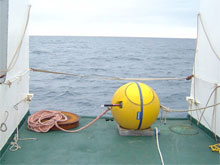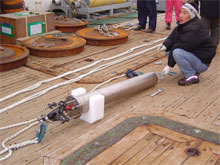King George Island, Antarctic
December 7, 2005
William Hanshumaker
Oregon State University
Public Marine Education Specialist
Extension Sea Grant Faculty
Weather: Mostly sunny with temperatures hovering around above +2C(34F),
Winds: Variable between 0-10 knots
Seas: Calm, but building to a light chop
It is difficult to believe that we are on some of the most dangerous waters of the planet, when you awake to discover a tranquil blue sea surrounded by dazzling white islands. The sky is crystal clear, and there isn't a breeze in the air. Both small and large icebergs are visible on every point of the compass; one appears to be a significant block from an ice sheet. Livingston Island is off our starboard side and Deception Island is directly forward. The conditions are perfect for sighting birds and whales. Though seabirds continually fly into view, we wait patiently to spot blows from a whale; if there are any we will surely see them.
The weather is also ideal for deploying our hydrophones. With
the calm seas, deck work precedes quickly. A short length of chain
and 3/4" nylon rope is attached to a syntactic foam float. Then the
large "A" frame crane on Yuzhmorgeologiya's stern lowers it into
the
ocean. As the ship slowly steams forward, the nylon rope unwinds
from a large spool: the rope length depends on the depth at this
location. The acoustic release is then joined to this assembly with
wire and chain. The heavy railroad wheel anchor is the last part
added and lowered over the side by the "A" frame. Finally, the
entire apparatus is free from the ship: a long length of float,
hydrophone, acoustic release and mooring anchor that will hopefully
withstand the rigors of an Antarctic winter.
The "Haruphone" hydrophone on the deck of the Yuzhmorgeologiya. Click image for larger view and image credit.
Before departing to the next deployment, the hydrophone mooring location has to calibrated. Researchers use the ship's Global Positioning Satellite (GPS) system as it moves in a large circle to triangulate the exact position of the transponder located in the acoustic release. Without knowing the precise coordinates of each hydrophone, scientists will not be able to calculate the exact location of underwater seismic disturbances that they expect to record.
Through the combination of fine weather and hard work, the "Sounds of the Southern Ocean" team was able to assemble, deploy and calibrate three hydrophones today. Six of the seven hydrophones are to be located in this region of the Bransfield Strait. The final remaining hydrophone is scheduled for installation in the Drake Passage.
During the last three days Sara has sighted and identified the
following bird specie: (KG-King George Island; BS-Bransfield Strait)
Gentoo penguin (Pygoscelis papua) KG
Chinstrap penguin (Pygoscelis antarctica) KG
Southern Giant Petrel (Macronectes gigcialoides) KG, BS
Cape Petrel (Daption capense) BS
Southern Fulmar (Fulmarus glacialoides) BS
Antarctic Prion (Pachyptila desolata)
Wilson's Storm-petrels (Oceanites oceanicus) BS
Antarctic Shag (Phalacrocorazx (atriceps) bransfieldensis) KG
Subantarctic Skua (Catharacta antarctica lonnbergi) KG, BS
South Polar Skua (Catharacta maccormicki) KG, BS
Kelp Gull (Larus dominicanus) KG, BS
Antarctic Tern (Sterna vittata) KG, BS
Antarctic Petrel (Thalassocia antarctica) BS
Sounds of the Southern Ocean will be sending several reports from Dec 3 - 13. Please check back for additional logs from this expedition.
Sign up for the Ocean Explorer E-mail Update List.















